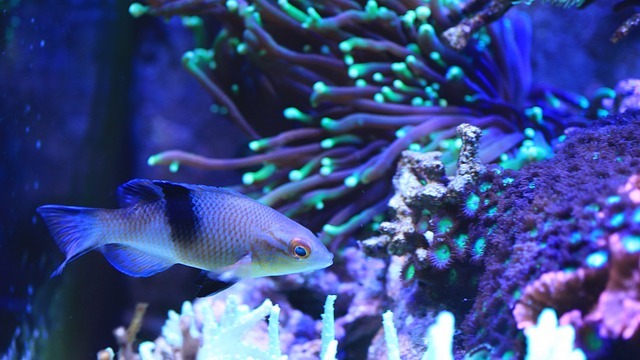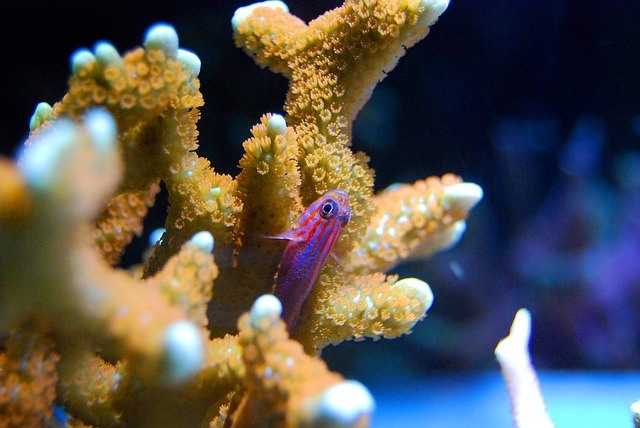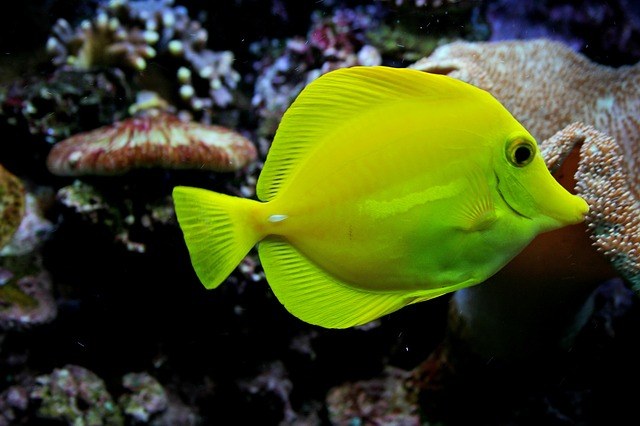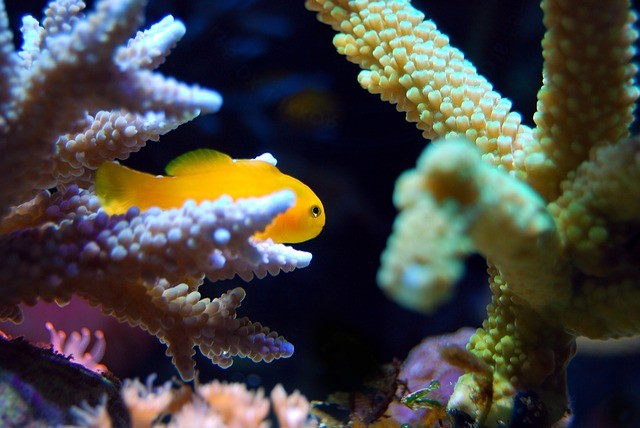While there are many beautiful freshwater fish available for aquarists to enjoy, one can’t deny the most colorful, exotic, and lively species around tend to be found in saltwater.
After all, who hasn’t watched Finding Nemo and reconsidered their normal aquarium set-up in favor of one to hold a Nemo and Dory?
As you may know, however, saltwater tank set up is no easy venture. There is a great deal of equipment needed, more logistics involved with its upkeep, and establishing one from scratch requires a fair amount of know-how.
With all that said, if you’re ready to dive into saltwater fish keeping, where do you start?
What are the differences between a freshwater and saltwater tank, despite the obvious? Can you do it without seeking professional help?
We’ll answer all that and more, so read on!
Contents
Saltwater vs. Freshwater Tank
Contrary to what The Shape of Water implied, saltwater tanks aren’t just water with table salt and a few tablets.
On the contrary, there are numerous chemical levels to monitor and maintain, so as to guarantee the environment mimics that which your fish are used to.
If one level becomes slightly irregular, it could spell disaster for your entire tank. More-so, with this completely new ecology in your tank, you’re also opening the door for new sicknesses to affect your fish, which you may be inexperienced with.
Aside from that, saltwater fish are notoriously sensitive and finicky. They are prone to illnesses, are highly particular about environmental changes, and tend to react to stress more adversely.
Their tankmates have to be chosen carefully, as do their toys, decorations, and hiding spots. Most of all, saltwater fish cost more than their freshwater counterparts, making it far more disappointing (and expensive) if they pass away.
As such, freshwater tanks are recommended to beginners, as they require less investment and the species within are far more resilient. There will also be a larger number of fish and fauna available for freshwater tanks since their demand is higher.
But what if you don’t have that much experience, and you really want your own saltwater aquarium set-up? Not to worry. While saltwater aquariums are harder to maintain, it’s not impossible to do, even for a complete beginner.
This is especially true thanks to modern technology and equipment, which can better assist you in regulating your tank.
These tools have greatly reduced the difficulty of fish-keeping by updating you on the conditions, notifying you of issues, maintaining levels independently, and ensuring mistakes are easy to reverse.
As such, what do you need for a saltwater tank?
Saltwater Tank Equipment
In choosing the right equipment for your saltwater aquarium, it helps to go for brands that are known for their quality, so as to ensure they perform their best and don’t malfunction.
In the initial set-up of your tank, there will be only a few basic items that are mandatory, such as:
- A thermometer. Temperature plays a key role in your fish species’ health, and each will have their own unique preferences.
- Saltwater fish are more susceptible to illness, making them less forgiving of a dirty tank. As such, your filter will need to be stronger than those used in freshwater.
- Light bar. You will need quite a few plug-ins, so be sure to invest in one that also includes a surge protector. Going without power could lead to disaster for your tank.
- For both viewing your fish and giving them a proper day/night routine, lights will be crucial.
- Test kits. As discussed, chemical levels in your tank will make or break your venture. Test kits will help you keep track of everything.
This guide can provide a more detailed understanding of the equipment that you may need.
How to Set Up a Saltwater Fish Tank
Location
- You do not want your tank to be in direct sunlight, as this can cause mold and discoloration.
- Be sure your tank isn’t located in a place that is prone to temperature fluctuations, such as near heaters and air conditioners.
- Noise levels are also key, so avoid areas that have a lot of foot traffic, such as by a door.
- Make sure to leave enough space around the tank for you to do maintenance.
- And lastly, make sure that it’s still in a place where you can enjoy it. It’s not all work and no play, after all!
Pick Your Type of Tank
Each tank entails varying levels of difficulty to maintain, so it’s best to start with the non-reef types.
These types are a fish-only (FO) tank, or a fish-only with live rock (FOWLR) tank. You can easily upgrade this to a reef tank once you have grown used to caring for your fish in a saltwater environment.
Of course, it’s always a good idea to research the best type of tank that fits you.
While considering your skill level and prior experience is important, you should also consider the type of look you are going for, as well as the level of dedication that you are willing to devote to your tank.
Pick a Tank
Now it’s time to actually pick out the tank itself. For those who are already used to caring for freshwater fish, the process is very similar.
You will need to pick between either a glass or an acrylic tank.
Acrylic tanks are more beginner-friendly, as they tend to be more durable and resistant to scratches.
They’re also cheaper and lighter in weight, making it easy to move them from one area to the next or to buy multiple, should you wish to expand your fish keeping hobby.
Glass tanks, however, require less maintenance and provide a clearer view of your fish. As such, it depends on your preferences and level of dedication.
All that matters is that your chosen tank is large enough to home the number of fish you plan on keeping.
It’s also worth noting that the bigger the aquarium, the easier it will be to maintain, as it will give you enough space to correct any mistakes before they ruin the entire aquarium.
Set Up Your Tank
Now that you have all your materials ready, you can establish your tank.
Even if you’ve bought your tank brand new, be sure to rinse it thoroughly before proceeding. There may be leftover bacteria or chemicals from the manufacturing process that can contaminate the water.
When rinsing the tank, do not use any soaps or detergent; this can stick to or be absorbed by your tank, which will also contaminate the water. Stick with tap water and a clean cloth.
Put in Prepared Seawater
Now it’s time to add water. For the greatest ease (and the highest chance of success), we recommend buying a professional saltwater mix. Here is a guide for choosing the right variety.
Before adding the mix, make sure that your gravity reading measures between 1.021 and 1.024. Let this water circulate for about one to two days before moving on to the next step.
When it’s ready, follow the instructions of your mix to prepare your seawater – and you’ll be half done!
Put in Live Rock and Cure the Tank
Now that your tank is filled with seawater, you can add any live rock that you’ve picked out.
As with everything that you put in your tank, clean your live rock in advance. This can be done by gently rinsing it in a bucket of prepared seawater.
You will also need to cure your live rock at this time, as described here. After this, every few days, clean your live rock with a brush to remove organisms and siphon out loose organic debris.
Change half the water in your tank every week while curing.
Your tank may smell bad during the curing process, but you will know it’s done once the smell dissipates.
Regularly check your water to ensure that the curing process is going smoothly; at the end, you should have zero ammonia and zero nitrites present. This process can take about four weeks.
After curing, adjust the pH levels to that of about 8.1 to 8.4.
Add Substrate
Rinse your substrate with saltwater, and then add slowly to your aquarium. This process should be done gradually, rather than all at once, so be sure to use a ladle of some sort. Should your live rock get any on its surface, make sure to remove it.
Then, let the tank settle. This is a great time to ensure that all the levels in your tank are properly achieved.
Make a reading daily, so as to confirm the conditions are aligned before adding in fish.
Choose Your Fish
Before adding fish, you’ll, of course, need to decide on the species to purchase! This isn’t a matter of aesthetic choice, but of compatibility.
Will your fish be well suited in the tank conditions you’ve created, or does the aquarium need to be further tailored?
What are the species’ behaviors, and which tank mates do they pair well with? Do those tank mates need altered conditions as well?
This guide can help you figure out the best fish for your saltwater tank while considering all these parameters.
This video gives examples of some fish suitable for a saltwater tank setup.
Add Your Fish
Now comes the fun part – adding fish to your aquarium. Before you can add the fish, however, make sure to keep them in quarantine.
A quarantine tank is a separate aquarium that has similar conditions to your main tank. Quarantine is necessary to guarantee that your fish don’t have diseases that can pass on to other tank mates; it also allows the fish to acclimatize in their new environment.
After quarantine, add one or two fish at a time. This will help your tank adjust to the added biomass of the fish, ensuring that levels can still keep up with the new additions.
Should you need to adjust the conditions of the tank, do so slowly. Of course, you’ll need to wait and see if the tank can level out the conditions all on its own.
Add Invertebrates
If you have elected to add invertebrates to your tank, now is the time to do so.
Invertebrates are a great way to keep your tank clean, as they can remove the organic debris that has fallen to the bottom of your aquarium.
As with the fish, make sure to quarantine your invertebrates before adding them to your main tank.
Maintenance
Maintenance is a key part of owning a saltwater tank, and is arguably the most difficult task for you to handle.
It can be a rigorous process, but with enough time, you will get used to the routine of checking your tank and its unique levels.
At least once a week, make sure to test the conditions of your water to ensure that everything is up to snuff.
Should there be an issue, you can modify this with water conditioners, a filter change, or specialized tablets designed to reverse irregularities. So long as your testing kit can identify the problem, fixing it is as simple as adding or removing an element.
Be sure to change a fourth of the water once a month, and clean out your filters at the same time.
Even with invertebrates, organic matter will build up and begin to affect the quality of your tank. By keeping it regularly cleaned, your fish will continue to live healthily in a fresh environment.
The Spruce Pets also recommends keeping a tank log book to record the conditions of your tank as well as any changes that you made yourself, such as adding fish or equipment.
This will help you more readily identify mistakes, should there be an unexpected change to your aquarium.
Here’s a video explaining more on a saltwater tank setup.
Your New Saltwater Aquarium
While saltwater tanks are harder to set up than freshwater varieties, most of the difficulty associated with them is in the wait.
It takes significantly longer to set up a saltwater aquarium, but with enough patience, you can be rewarded in the form of a thriving, colorful ecosystem.
Even beginners can enjoy this change of scenery, with enough dedication.
What’s your favorite saltwater tank setup?






